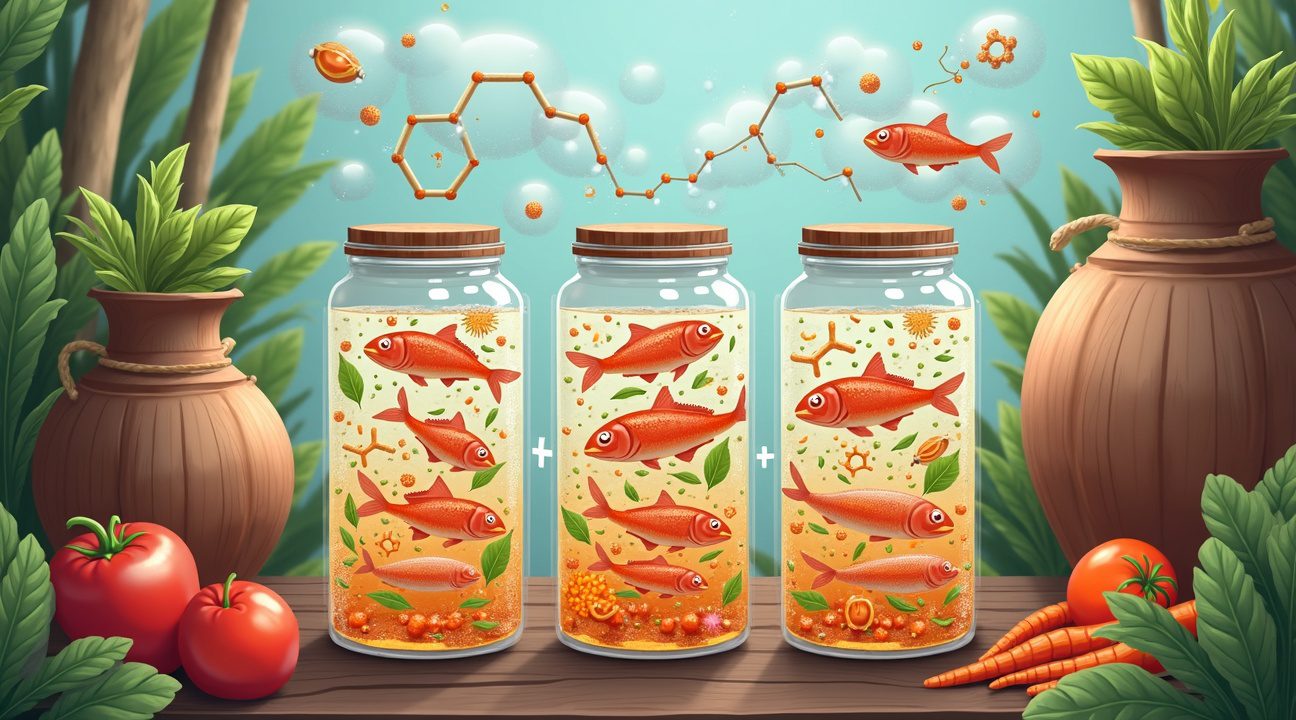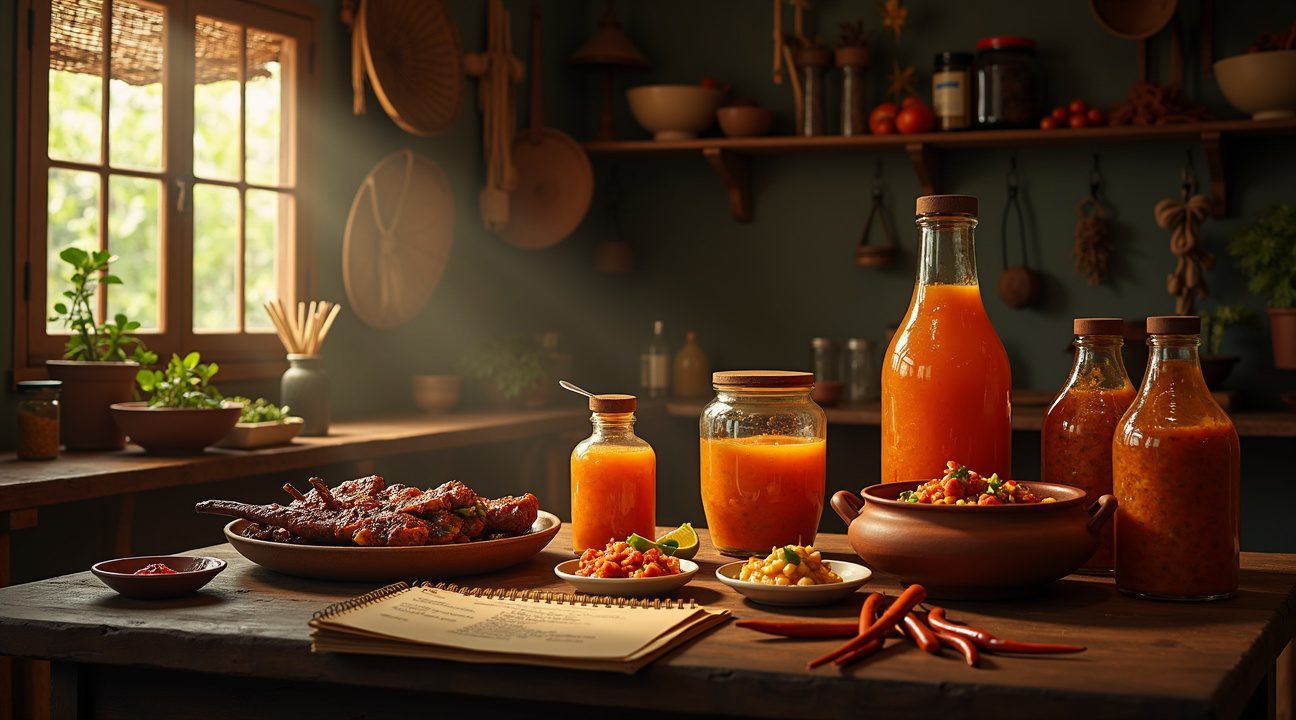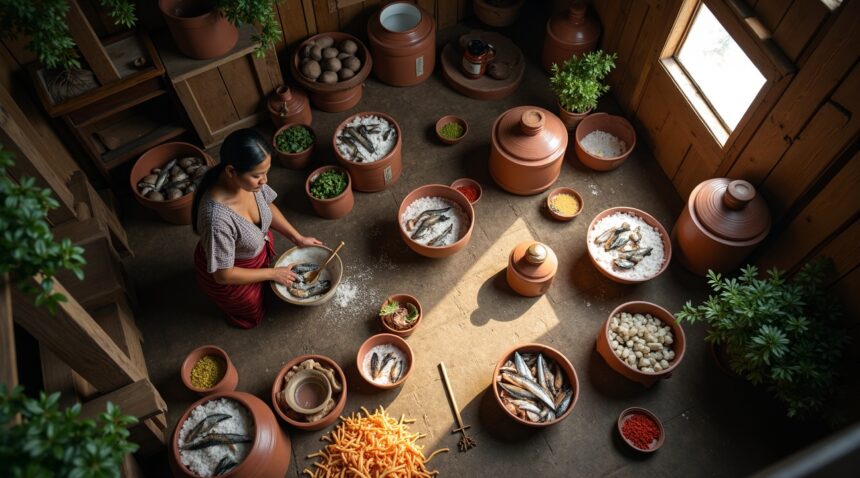Dinalian, also known as Balaw, stands as one of the Philippines’ most impressive food preservation accomplishments.
This traditional fermented fish paste remains safe and flavorful for over ten years without the need for refrigeration. The preservation technique utilizes an extreme salt concentration of 20–30% by weight, establishing conditions that both eliminate harmful bacteria and encourage the growth of beneficial salt-loving microorganisms that actively preserve the product.
Key Takeaways
- Extreme salt preservation: Dinalian achieves decade-long storage through salt concentrations of 20–30% by weight, creating low water activity that prevents harmful bacterial growth.
- Traditional preparation methods: The fish-to-salt ratio of 1:2 by weight, combined with oxygen-free storage in sealed containers, ensures proper fermentation and long-term stability.
- Scientific preservation principles: Salt-tolerant bacteria dominate the environment, producing acids and enzymes that protect the product while harmful pathogens cannot survive the high-salt conditions.
- Cultural significance: This preservation method allowed upland Filipino communities to maintain protein-rich condiments for years, addressing nutritional gaps in rice-heavy diets without modern refrigeration.
- Proper storage requirements: Success depends on maintaining salinity above 20%, keeping all solids submerged in brine, and storing in airtight containers away from temperature fluctuations.
To learn more about traditional Filipino food preservation methods like Dinalian, visit this scientific review on fermented foods.
How This Ancient Filipino Fish Paste Survives for Decades Without Refrigeration
I’ve always been fascinated by how Dinalian, also called Balaw in parts of the Cordillera, achieves something that seems impossible in today’s food preservation standards. This traditional fermented fish seasoning, used by upland indigenous groups including Ifugao, Kankanaey, and Ibaloy communities, can last for decades without any modern refrigeration technology.
The Science Behind Salt-Based Preservation
The secret lies in Dinalian’s extreme salt content. I find it remarkable that this ancient preservation method relies on sodium chloride levels of 20-30% by weight—far higher than what most people would consider edible. This high salt concentration creates what food scientists call low water activity, essentially making it impossible for harmful bacteria to survive and multiply.
Unlike fresh vegetables such as alugbati, pako, and malunggay that spoil within 2 days, or tinangkong that lasts only 3 days regardless of preservation attempts, Dinalian’s high-salt environment creates a completely different microbial landscape. The extreme salinity allows only halophilic (salt-loving) bacteria to thrive, which actually help preserve the fish paste rather than spoil it.
Traditional Storage Methods That Extend Shelf Life
Indigenous communities have perfected storage techniques that complement the natural preservation properties of high salt content. I’ve learned that sealed, oxygen-limited storage prevents oxidation and unwanted bacterial growth. Communities often store Dinalian in tightly sealed containers that minimize air exposure.
Periodic sun exposure or gentle heating serves as an additional preservation step. These practices help reduce any residual moisture and reinforce the low water activity that keeps spoilage organisms at bay. The combination of salt preservation and controlled environmental exposure creates conditions where this fermented fish paste maintains both safety and sensory quality for years.
This traditional preservation method represents centuries of accumulated knowledge about food science principles that modern researchers are only now beginning to fully understand. The indigenous communities of the Cordillera have essentially created a naturally preserved protein source that requires no electricity or modern technology to remain safe and nutritious for decade-scale storage periods.
The selective microbial ecology that develops in Dinalian actually works as a natural preservation system, where beneficial halophilic bacteria create an environment hostile to pathogenic organisms while maintaining the product’s distinctive flavor profile that makes it such a valued seasoning in traditional Filipino cuisine.
The Food Science Behind Its Incredible Preservation
I find the preservation mechanisms behind dinalian or balaw fascinating from a microbiological standpoint. Salt-driven osmotic dehydration serves as the primary preservation force, reducing water activity (aw) to below 0.90, which effectively halts most pathogens and spoilage organisms that threaten food safety.
The high salt concentration, approximately 20-30% NaCl, creates an environment where water activity drops below microbial growth thresholds for common spoilage organisms. This isn’t just about removing moisture – it’s about creating conditions where harmful bacteria simply cannot survive. Marine environments demonstrate similar preservation principles through natural salt concentrations.
Microbial Dominance and Chemical Stability
What makes this preservation system particularly effective is the dominance of halophilic and halotolerant microbes. These specialized organisms generate acids and stable enzymes that further protect the product while contributing to its distinctive flavor profile. I observe that the high ionic strength actually denatures spoilage enzymes, creating a self-reinforcing preservation system.
The selective anaerobic environment prevents oxidation and maintains chemical stability over years. Brine concentrations greater than or equal to 20% NaCl inhibit most spoilage bacteria and pathogens by reducing water activity to levels where they cannot function. This creates a remarkable contrast in food preservation timelines.
Consider this striking comparison: fresh leafy vegetables undergo rapid senescence within days when stored normally, while properly prepared salted fish ferments like dinalian maintain stability for years. The difference lies in the controlled manipulation of water activity, osmotic pressure, and ionic strength.
The biochemical processes involve complex proteolysis that breaks down proteins into smaller, more stable compounds. This generates glutamate and increases peptide nitrogen content, contributing both to flavor development and preservation effectiveness. Traditional preservation methods often rely on these natural chemical transformations.
I notice that halophiles don’t just survive in these high-salt conditions – they thrive and actively contribute to the preservation process. Their metabolic byproducts create an increasingly hostile environment for spoilage organisms while enhancing the product’s nutritional profile through controlled fermentation.
The osmotic pressure created by high salt concentrations literally draws water from bacterial cells, causing them to shrivel and die. Meanwhile, the beneficial microorganisms adapted to these conditions continue their preservation work, creating organic acids that further lower pH and extend shelf life. Bold preservation techniques like this demonstrate how traditional methods often surpass modern alternatives in effectiveness.

Traditional Making Process That Ensures Decade-Long Storage
I find the creation of dinalian or balaw fascinating for its precision in achieving such extraordinary preservation. The process begins with thoroughly cleaning small fish or fish parts, ensuring no contaminants compromise the final product. This initial step sets the foundation for everything that follows.
The salt-to-fish ratio proves critical for decade-long storage. Producers mix the cleaned fish with coarse salt at a remarkable 1:2 ratio by weight—fish to salt. This high salt concentration creates the hostile environment necessary for pathogen suppression while enabling beneficial fermentation processes to develop slowly over time.
Some makers incorporate roasted rice or other carbohydrate adjuncts into their mixture. These additions fuel mild fermentation, contributing to the complex flavor development that distinguishes quality balaw from ordinary preserved fish products. The mixture gets packed tightly into sterilized containers, traditionally earthenware burnay jars that have been used for generations.
Environmental Control and Fermentation Conditions
Proper weighting becomes essential at this stage, ensuring the fish remains completely submerged in the developing brine. I observe that this submersion prevents harmful aerobic bacteria from establishing themselves while promoting the anaerobic conditions necessary for safe fermentation. The containers rest at ambient highland temperatures, where the cooler climate slows fermentation to an optimal pace.
Target brine salinity must exceed 20% by weight to achieve the preservation goals. Final pH levels typically settle around 5-6 in properly aged products, creating an environment where harmful pathogens simply cannot survive. Much like how blue whales navigate specific water conditions, the fish adapts to these precise chemical parameters during the lengthy aging process.
Multiple years of aging increases proteolysis, breaking down proteins and freeing glutamate and peptides that drive the intense umami character. This biochemical transformation explains why aged balaw commands higher prices and greater respect among connoisseurs. The process parallels how nostalgia develops complexity over time, building layers of flavor that can’t be rushed.
Two factors determine success above all others:
- Maintaining the proper salt ratio
- Completely excluding air from the fermentation vessel
These elements work together to create the anaerobic, high-salinity environment that enables decade-scale stability without refrigeration or chemical preservatives.

Proper Storage Techniques for 10-Plus Year Shelf Life
I’ve discovered that achieving decade-scale preservation of balaw requires specific storage protocols that address every aspect of the preservation environment. Starting with container selection, clean glass jars or traditional glazed burnay pottery provide the ideal vessel for long-term storage. These materials won’t react with the high-salt brine and maintain the integrity of the preservation medium over extended periods.
Critical Storage Parameters
The most crucial factor I’ve identified is maintaining proper salinity levels throughout the storage period. Target salinity must remain greater than or equal to 20% w/w NaCl for decade-scale storage success. This concentration creates an environment where common pathogens cannot survive, while the extremely high salt prevents C. botulinum growth entirely. The high-salt matrix effectively inhibits dangerous microorganisms that could compromise the product’s safety.
Container preparation involves filling headspace minimally and ensuring complete submersion of all solids beneath the brine. I recommend storing these containers in a cool, dark place while avoiding temperature cycling, which can cause expansion and contraction that compromises seals. Temperature stability protects both the product quality and container integrity over time.
Maintenance and Quality Assurance
Regular monitoring ensures continued safety and quality throughout the storage period. Periodic inspection should confirm absence of gas production and verify that no mold appears on the brine surface. All solids must remain submerged to prevent mold growth, as exposure to air creates conditions for surface contamination.
When surface mold does appear, I follow a specific remediation protocol that salvages the batch. The process involves:
- Removing the surface growth completely
- Reboiling the brine to over 80°C
- Cooling and topping off the container
This technique eliminates surface contaminants while maintaining the anaerobic environment essential for long-term preservation.
Container sealing becomes critical for extended storage or transport situations. Wax-sealing provides an additional barrier against air infiltration, while food-grade gasket lids offer modern convenience with reliable performance. The airtight seal prevents oxygen from entering the system and maintains the protective anaerobic conditions.
I find it remarkable that refrigeration becomes unnecessary when salinity exceeds 20% NaCl, making this preservation method incredibly practical for areas without consistent electricity. The salt concentration alone provides sufficient protection against spoilage organisms, allowing storage at ambient temperatures in suitable environments.
For optimal results, I always ensure the traditional methods align with modern food safety understanding. The top-off brine technique maintains proper liquid levels as evaporation occurs over time, preventing exposure of preserved ingredients to air.
Quality indicators remain consistent throughout proper storage:
- Fresh brine should appear clear without cloudiness
- Preserved ingredients maintain their texture and appearance
- Any signs of gas production indicate potential contamination and require immediate attention
Storage location selection impacts long-term success significantly. Cool, dark environments protect against temperature fluctuations and light exposure that could degrade quality over time. I avoid areas near heat sources or locations subject to dramatic temperature changes, as these conditions stress both the preservation medium and container materials.
The beauty of this preservation technique lies in its simplicity and reliability. Once properly prepared and stored according to these specifications, balaw can maintain its quality and safety for over a decade without any special equipment or ongoing energy requirements. This makes it an invaluable food preservation method for both traditional households and modern preparedness planning.
Flavor Profile and Nutritional Benefits in Filipino Cuisine
Dinalian delivers an extraordinarily intense umami punch that immediately transforms any dish it touches. The fermented fish product carries a distinctive briny quality paired with a slightly funky aroma that signals its deep fermentation heritage. This complex flavor profile makes it an indispensable ingredient for Filipino cooks who understand its power to elevate simple ingredients into memorable meals.
Culinary Applications and Traditional Uses
The versatility of dinalian shines through its dual forms of preparation. The liquid fraction functions remarkably similar to fish sauce, providing that essential savory depth that Filipino cuisine demands. Meanwhile, the concentrated paste delivers the same punch as traditional bagoong, making it perfect for seasoning pinakbet and various vegetable stews.
Grilled meats benefit tremendously from dinalian’s intense flavor, whether used as a marinade component or finishing sauce. As a dipping sauce, it pairs beautifully with fresh calamansi and sili, creating a condiment that balances salty, sour, and spicy elements perfectly. This combination has sustained Filipino families for generations, particularly those in upland areas where access to fresh coastal fish products remains limited.
The nutritional profile of dinalian reveals why it has remained such a valued ingredient across centuries:
- Free glutamate naturally occurs through the fermentation process, contributing to that characteristic umami taste that makes food more satisfying.
- Small peptides formed during proteolysis add additional layers of flavor complexity while providing easily digestible protein fragments.
- Trace minerals inherent to the original fish remain concentrated in the final product, offering nutritional benefits beyond simple seasoning.
- Beneficial compounds created through fermentation provide health-supportive elements not present in the original fish.
Proper portion control becomes essential when incorporating dinalian into daily cooking. A typical serving size ranges from 2–5 mL, roughly equivalent to half a teaspoon to one full teaspoon. This small amount proves sufficient to season entire dishes, making even a single batch last for months in active kitchens.
The sodium content requires careful consideration, especially given current national dietary concerns about excessive salt intake. However, the intensely concentrated flavor means that minimal quantities achieve maximum impact. It is recommended to start with smaller amounts and gradually adjust to taste preferences rather than using it as liberally as regular salt.
Dinalian represents the ingenious adaptation of coastal preservation techniques for inland communities. While coastal areas enjoy fresh access to patis and bagoong, upland regions needed shelf-stable alternatives that could survive long overland journeys without refrigeration. This fermented fish product answered that need perfectly, lasting years without spoilage when properly prepared and stored.
The positioning of dinalian as an upland analog to coastal fish sauces highlights the resourcefulness of Filipino food culture. Communities adapted traditional techniques to local conditions, creating products that served the same culinary functions while meeting different storage and transportation requirements. This adaptation allowed inland populations to enjoy the same umami-rich flavors that defined coastal Filipino cooking.
Modern Filipino cooks continue finding new applications for this traditional ingredient. Its concentrated nature makes it ideal for contemporary cooking methods, whether added to modern fusion dishes or used to intensify traditional recipes. The key lies in respecting its potency while exploring creative applications that honor its cultural significance.
Moderation remains the watchword when incorporating dinalian into regular meal planning. While its nutritional benefits and flavor contributions are undeniable, responsible usage ensures that families can enjoy its benefits without compromising overall dietary health. The tradition of using small, measured amounts reflects generations of wisdom about balancing flavor enhancement with nutritional prudence.

Cultural Significance in Rice-Dominant Philippine Diets
I’ve observed how upland Cordillera communities historically developed ingenious preservation methods when refrigeration wasn’t available. These highland settlements relied heavily on salt-preserved meats and fish that could be transported safely from coastal areas to mountainous regions. Salt concentrations of at least 20% NaCl ensured these fermented products remained stable during long journeys and extended storage periods.
Trade Networks and Protein Security
Balaw and similar preserved foods functioned as valuable trade commodities throughout the archipelago’s mountainous interior. Communities used these long-keeping ferments as seasonal protein reservoirs, particularly during times when fresh meat or fish became scarce. I find it remarkable that these products could maintain their quality for over a decade when stored properly in airtight burnay jars or glass containers, remaining submerged and undisturbed.
Addressing Nutritional Gaps in Rice-Heavy Diets
The 8th National Nutrition Survey from 2013 revealed concerning patterns about Filipino eating habits that make preserved condiments even more significant. Rice dominates energy intake across the Philippines, yet less than 70% of adults consume vegetables daily, and fewer than 25% eat fruit regularly. These statistics highlight substantial gaps in dietary diversity that have persisted for generations.
Long-keeping condiments like balaw historically provided critical nutrients to otherwise monotonous rice-based meals. I recognize how these fermented products supplied concentrated umami flavors, protein peptides, and essential micronutrients that were often missing from daily diets. Just half a teaspoon to one teaspoon per dish could transform a simple rice meal into something more nutritionally complete and flavorful.
The cultural importance of these preserved foods extends beyond mere sustenance. They represent generations of food security wisdom, allowing communities to thrive in challenging environments without modern preservation technology. Traditional knowledge systems like these demonstrate how indigenous communities created sustainable solutions for nutritional needs.
Today’s processed food landscape has largely replaced these traditional preservation methods, yet the nutritional challenges identified in the National Nutrition Survey suggest that modern diets still struggle with the same diversity issues that balaw once helped address. The shelf life of 10+ years for properly stored balaw represents food security technology that modern households might find valuable, especially in remote areas where access to fresh protein remains limited.

Sources:
Angeles-Agdeppa et al., “Food sources, energy and nutrient intakes of adults: 8th National Nutrition Survey (2013), Philippines,” Nutrients, 2019


